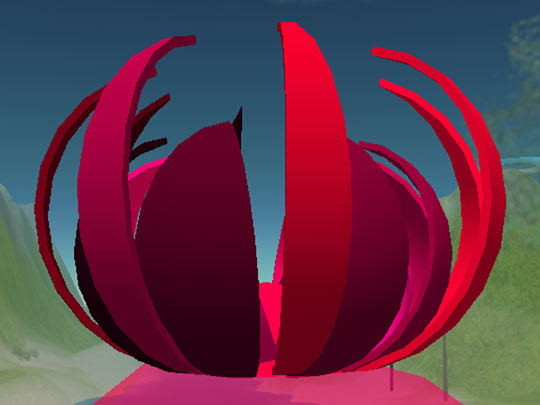Eudemonia Stellata (2007)

Eudemonia Stellata was an immersive audiovisual sculpture for Second Life by Adam Nash in 2007.
The virutal - is it immaterial? Immersion, is it virtual? Virtual reality, as has often been pointed out, is an oxymoron. Those seeking eudemonia in the real world, and failing, will surely fail in the virtual also. Better perhaps to give up the search? The Nietzschean urge to forgo any mode of thinking that measures the worth of things according to pleasure or pain (Beyond Good & Evil, Ch.VI, Para.225)?
Equally misleading is Stellata. The Eudemonia Stellata has 3 rings of 8 petals each: not stellata at all, but perhaps magnolia, lotus and oak carry or are eudemonia, without being anthropomorphic.
This work is an attempt to build an ambient muscial instrument specifically for a realtime 3D environment, where the playing of the instrument is as much a visual experience as aural. An experiment in immersion, where time slows, blurs or disappears.
The work uses a musical scale of my own devising, based on 77Hz with intervals proceeding in fracions of 7. It is the same scale used in one of my other works, Infra Assemblage. The cents-difference of the ratios are derived from Kyle Gann's chart Anatomy of an Octave, http://www.kylegann.com/Octave.html, but the calculations (and therefore any errors) are all my own. The sounds themselves are sine waves that I generated based on the ratio calculations. Since this is a rational scale, it may take a little time for the ear to get used to the difference from a standard western so-called Well Tempered Scale, but once accustomed, all the tones should sound consonant no matter which ones are played together. This is subjective of course, just like colour is.
As well as user-play, the work has an auto-play mode, using a psuedo-random number generator on a 3-minute cycle to decide which petals to play. This mode is for those who just wish to immerse or submerge themselves in the ambient digital formalism of it all, and is my preferred way of using this work. Autoplay mode turns itself off if no avatars are around, which doesn't bother the birds and insects since they are only digital soundfiles themselves and know what its like to be on a random play cycle.
The rotation uses llTargetOmega(), which is a client-side operation, so there is no guarantee that, if two or more people access the work together, they will be seeing or hearing it the same. This is an echo of the problem of the multi-user environment (you never know where the "eye" or "camera" of another avatar is), which is itself an echo of the problem of existence, which leads so many to pursue eudemonia... :)